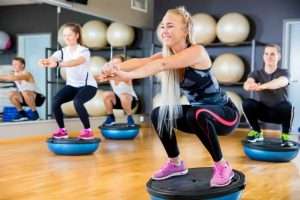How does it work?
Movement Preparation (or Movement Prep, for short) is not the conventional warm-up that you are probably familiar with. On the contrary, it makes you stronger, more stable and enables you to yield long-term flexibility gains. In a movement prep routine, each exercise has approximately 5-10 reps (per side where applicable) designed to prepare your muscles for an intense workout.
At first, the movement preparation itself might feel like enough of a workout especially if you are new to training. Over time, your body conditions itself to the Movement Prep period, leaving you ready for your workout without any fatigue.
What are the benefits?
- The sensory receptors at the joint capsules and ligament endings measure and identify pressure, movement, and rate of movement. Slow and controlled movements allow the nervous system to be able to regulate the degrees of freedom for each of our individual joint.
- Muscle and fascia both contain sensory receptors that sense tension and rate of length change. Movement prep engages sensory receptors in contractile and elastic tissues to fully involve your central nervous system, hence providing you control over your muscles and preparing them for your workout routine that follows the Movement Prep.
- As muscles stretch, the muscle spindles sense the rate of length change and communicate with motor receptors to initiate muscle contractions. Movement preparation exercises will increase the brain activity with respect to nervous system activity within muscles and makes them effective at producing powerful contractions during exercise.
- It causes the body temperature to rise, which in turn, causes the muscles to become more pliable and capable of stretching faster. This will also reduce the risk of strains or acute injury.
- The controlled contractions during movement preparation exercises use the principle of reciprocal inhibition to allow muscles to lengthen and prepare for activity.
Movement Preparation will awaken muscles that may have become slightly dormant. People who suffer from muscle weakness will unconsciously over-use other muscles to compensate for this. Movement prep can help to address this issue, allowing your body to activate the correct muscles during an exercise while helping improve your coordination.
The difference between movement prep and static stretching is that the latter helps relax your muscles by stretching and holding the position for a period of time such as 30-60 seconds. Whereas movement prep actively elongates your muscles as well as contracts them, making them active and ready to engage. In the long run, it will help improve the mobility and flexibility of your muscles rather than simply having them stretched and return to their usual position. Movement Prep helps your body remember the range of motion and better improve your stability and mobility in the long run.
Movement Preparation makes your body stronger and improves your balance. It helps you increase your speed in running and enhances your power output. Making sure that you make Movement Prep a priority before your workout will give you greater flexibility as well as properly warm you up for your ensuing workouts.
Below is a simple Movement Preparation sequence that you can use prior to a Total Body strength training session (approximately 5 minutes):
A1) Thoracic Spine Rotation—Quadruped—Hand on Back of Head—Internal to External Rotation
- 1 set, 5-6 reps per side then transition to the next movement within 15 seconds
A2) Hip Adductor Stretch—Quadruped—Rock Back
- 1 set, 5-6 reps per side then transition to the next movement within 15 seconds
A3) Reverse Lunge—Elbow to Instep—In Place
- 1 set, 5-6 reps per side then transition to the next movement within 15 seconds
A4) Handwalk—Traveling
- 1 set, 3-4 reps then transition to the next movement within 15 seconds
A5) L Raises—Standing—TRX—Assisted Stance
- 1 set, 8-10 reps, transition to the beginning of your strength session within 60 seconds
Thoracic Spine Rotation—Quadruped—Hand on Back of Head—Internal to External Rotation
Primary Muscle(s): Core
Secondary Muscle(s): Upper Body
Starting Position: Sit back on your heels and face down toward the ground. Place your right hand behind your head; rotate the torso so that your right elbow is almost touching the left forearm and your left hand is outstretched on the ground in front of you.
Execution: Rotate your right shoulder and elbow toward the ceiling while exhaling, stretching the front of the torso and hold for 1-2 seconds. Return to the bottom position with the right elbow almost touching the left forearm; continue for the prescribed repetitions; switch sides and repeat on the other side.
Coaching Tips:
Maintain a tight torso.
Keep your hips square.
With each repetition, exhale as you rotate and inhale as you return to the start position.
At the top of the rotation, your elbow should be in line with your downed hand.
The majority of the rotation should be coming from the Thoracic Spine, not the Lumbar Spine.
Movement Regression:
Thoracic Spine Rotation—Quadruped—Hand on Back of Head—External Rotation
Movement Progression:
Thoracic Spine Rotation—Quadruped—Reach Through and Rotate—Foam Roller
Hip Adductor Stretch—Quadruped—Rock Back
Primary Muscle(s): Lower Body
Secondary Muscle(s): Core
Starting Position: Start in a Quadruped position (i.e., on all fours) with your knees directly under your hips and your hands directly under your shoulders.
Execution: Slowly shift your hips back toward your heels while still maintaining a neutral spine (i.e., straight line from hips to head). Pause for 1-2 seconds in this end range position; return to the start position; continue for the prescribed number of repetitions; switch sides and repeat on the other side.
Coaching Tips: Try to maintain a neutral spine.
Movement Regression: If you are very tight, you can raise your hands and knees up on some Airex pads or some 3” high small steps in order to help you get into the position.
Movement Progression:
Hip Adductor Stretch—Quadruped—Rock Back—Torso Rotation (Option 1)
Hip Adductor Stretch—Quadruped—Rock Back—With Hip Swivel (Option 2)
Reverse Lunge—Elbow to Instep—In Place
Primary Muscle(s): Lower Body
Secondary Muscle(s): Core
Starting Position:Stand in an upright position.
Execution: Take a large step backward with your right foot into a lunge position and bend your left knee until your thigh is parallel to the floor. Lean your torso forward so it almost parallel to the floor while placing your right hand on the floor (in line with your left foot), and then bring your left elbow down to the inside of your knee towards the instep of your left foot. Pause in this position; feel the stretch; lift your torso back into an upright position and push down through your left foot to return to the starting position. Continue for the prescribed number of repetitions; switch sides and repeat on the other side.
Coaching Tips:
Keep your back knee off ground.
Contract the back glute during the stretch.
Always posture up (i.e., bring the torso to an upright position) before returning to the start position.
Movement Regression:
Reverse Lunge—In Place
Movement Progression:
Reverse Lunge—Elbow to Instep—Straight Leg Ext—In Place (Option 1)
Reverse Lunge—Elbow to Instep—Torso Rotation—In Place (Option 2)
Handwalk—Traveling
Primary Muscle(s): Total Body
Secondary Muscle(s): None
Starting Position: Stand with your feet about hip-width apart and bend over at the waist so your hands are touching the floor.
Execution: Walk your hands out into a pushup position while keeping the knees straight. Briefly, pause; walk your hands out again and continue to repeat for the prescribed number of repetitions.
Coaching Tips: Keep your core tight & Keep your knees straight.
Movement Regression: Decrease the distance that you walk your hands out.
or
Handwalk—In Place
Movement Progression:
Increase the distance that you walk your hands out (i.e., hands past the top of your head).
L Raises—Standing—TRX—Assisted Stance
Primary Muscle(s): Total Body
Secondary Muscle(s): None
Starting Position: Grab the TRX with one handle in each hand. Place one foot slightly in front of the other in an offset stance and lean back. Keep your entire body in a straight line. Palms facing each other.
Execution: With your palms facing downward, pull your elbows back until they are in line with your shoulders. Then externally rotate your arms until your wrists are above your elbows. Reverse the movement and return to the start position. Repeat for the prescribed number of repetitions.
Coaching Tips: Make sure you maintain control while performing the movement especially when returning to the start position. Make sure you retract your shoulders blades as you finish pulling your elbows back and before you externally rotate your arms. The second part of the movement (i.e., the external rotation) will have various ranges of motion depending on your strength and flexibility of your shoulder joint.
Movement Regression: Decrease the angle of your body by walking your feet further from the anchor point.
or
Y Raises—Standing—TRX—Assisted Stance
Movement Progression:
Increase the angle of your body by walking your feet closer to the anchor point.



